Розрахунок поглиненої дози матрицею боросилiкатного скла та її модельне опромiнювання
Анотація
Стан поводження з рiдкими радiоактивними вiдходами (РРВ) на АЕС України характеризується вiдсутнiстю завершеного технологiчного циклу вiд переробки до отримання кiнцевого продукту, придатного для подальшого тривалого зберiгання або захоронення. В результатi резервуари для донного залишку (ДЗ) заповненi на 65-75%
(Запорiзька та Пiвденно-Українська АЕС), а ресурс розмiщення соляного розплаву на Запорiзькiй АЕС (92,7%) близький до вичерпання [1]. Тому розробка технологiй i матерiалiв для затвердiння РРВ АЕС є актуальною i спрямована на забезпечення переробки РРВ до твердого стану, який вiдповiдатиме критерiям прийнятностi для захоронення в централiзованих сховищах. Одним iз ефективних методiв затвердiння РРВ є їх осклування. Основна перевага вiтрифiкацiї полягає в тому, що пiд час процесу вiтрифiкацiї об’єм вiдходiв зменшується в кiлька разiв, що економить дороге мiсце для зберiгання [2, 3]. Метою цiєї роботи є розрахунок поглиненої дози, яку накопичують матрицi з боросилiкатного скла з доданим залишком дна протягом 300 рокiв зберiгання, а також дослiдження впливу iмiтованого рентгенiвського опромiнення на їхнi фiзико-механiчнi властивостi.
Завантаження
Посилання
S.Y. Sayenko, V. Shkuropatenko, A. Pylypenko, A. Zykova, S. Karsim, V. Andrieieva, and S. Moshta, PAST, 2, 103 (2020), https://vant.kipt.kharkov.ua/ARTICLE/VANT_2020_2/article_2020_2_103.pdf.
N. Laverov, B. Omelchenko, S. Udincev, S. Stefanovskii, and B. Nikonov, Geology of ore deposits, 55, 87 (2013). (in Russian)
M. Ozhovan, and P. Poluektov, Priroda, 3–11 (2010). (in Russian)
S. Luo, J. Sheng, and B. Tang, Journal of nuclear materials, 298, 180 (2001), https://doi.org/10.1016/S0022-3115(01)00592-X.
S. Agostinelli, J. Allison, K. Amako, J. Apostolakis, H. Araujo, P. Arce, M. Asai, et al, Nuclear Instruments and Methods in Physics Research Section A: Accelerators, Spectrometers, Detectors and Associated Equipment, 506, 250 (2003), https://doi.org/10.1016/S0168-9002(03)01368-8.
J. Allison, K. Amako, J. Apostolakis, H. Araujo, P. Arce Dubois, M. Asai, G. Barrand, et al, IEEE Transactions on Nuclear Science, 53, 270 (2006). https://doi.org/10.1109/TNS.2006.869826.
J. Allison, K. Amako, J. Apostolakis, P. Arce, M. Asai, T. Aso, E. Bagli, and et al, Nuclear Instruments and Methods in Physics Research Section A: Accelerators, Spectrometers, Detectors and Associated Equipment, 835, 186 (2016). https://doi.org/10.1016/j.nima.2016.06.125.
S.V. Stefanovskii, The Soviet Journal of Glass Physics and Chemistry, 16 (1991). (in Russian)
S. Stefanovskii, I. Ivanov, A. Gulin, and F. Lifanov, Radiokhimiya, 35, 106 (1993). (in Russian)
Авторське право (c) 2022 Володимир В. Моргунов, Сергій Ю. Саенко, Володимир А. Шкуропатенко, Євгеній О. Свiтличний, Олена П. Березняк, Cергій В. Литовченко, Володимр О. Чишкала

Цю роботу ліцензовано за Міжнародня ліцензія Creative Commons Attribution 4.0.
Автори, які публікуються у цьому журналі, погоджуються з наступними умовами:
- Автори залишають за собою право на авторство своєї роботи та передають журналу право першої публікації цієї роботи на умовах ліцензії Creative Commons Attribution License, котра дозволяє іншим особам вільно розповсюджувати опубліковану роботу з обов'язковим посиланням на авторів оригінальної роботи та першу публікацію роботи у цьому журналі.
- Автори мають право укладати самостійні додаткові угоди щодо неексклюзивного розповсюдження роботи у тому вигляді, в якому вона була опублікована цим журналом (наприклад, розміщувати роботу в електронному сховищі установи або публікувати у складі монографії), за умови збереження посилання на першу публікацію роботи у цьому журналі.
- Політика журналу дозволяє і заохочує розміщення авторами в мережі Інтернет (наприклад, у сховищах установ або на особистих веб-сайтах) рукопису роботи, як до подання цього рукопису до редакції, так і під час його редакційного опрацювання, оскільки це сприяє виникненню продуктивної наукової дискусії та позитивно позначається на оперативності та динаміці цитування опублікованої роботи (див. The Effect of Open Access).








